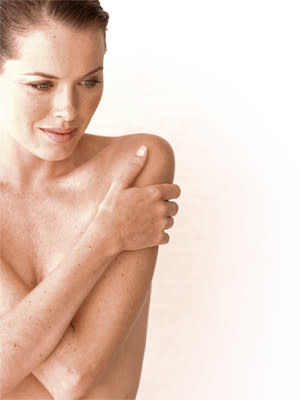Have Healthy Breasts at Every Age

By Alyssa Shaffer
Good-for-You Guide
You've supported them in hundreds of bras, figured out what shirts make them look bigger (or smaller)--maybe nourished your kids with them. You want to give your breasts the respect they deserve. As they change with time, the way you take care of them needs to shift as well. Photo by Cole/Jump Fotoagentur.
30s
Your breasts may be: Feeling PMS-related aches and lumps, and changing through pregnancy and breastfeeding.
Take action
TRY A SUPPLEMENT COCKTAIL. A combo of 100 to 200 mg of vitamin B 6 , 200 to 400 IU of vitamin E and two capsules of evening primrose oil taken daily for one week before your period can ease breast discomfort. The vitamin B helps stop swelling, and the vitamin E and evening primrose oil help relieve pain. (Check with your doctor.)
KNOW WHAT'S NORMAL FOR YOU. Do monthly self-exams so you can spot changes more easily. Keep in mind that there's a slightly higher rate of breast cancer during the five years after pregnancy, and tell your doctor about changes like bleeding or lumps ASAP.
40s
Your breasts may be: Starting to feel softer (and look less-than-perky), since you're developing more fatty tissue.
Take action
HAVE A MAMMOGRAM. Although the U.S. Preventive Services Task Force advises starting mammograms at age 50, groups like the American Cancer Society and the American College of Gynecologists and Obstetricians say to begin at age 40. At the very least, a mammogram in your early 40s will help establish a baseline so your doctor can better determine whether any changes are irregular.
WALK FOR AT LEAST 30 MINUTES DAILY. Since it helps you maintain a healthy weight and keep estrogen levels in check, any amount of exercise that ups your heart rate can help lower your breast cancer risk.
Related: Try these 20 easy ways to burn more fat.
50s, 60s and Beyond
Your breasts may be: Less dense as your tissue shrinks and less elastic as your skin loses collagen. You can still feel lumps and bumps and tenderness, particularly as you head into menopause. But once your periods stop and your hormones settle, the discomfort should subside.
Take action
DISCUSS HORMONE THERAPY (HT) WITH YOUR DOCTOR. The latest research shows that taking estrogen and progesterone together for less than three years does not raise your risk of breast cancer. Taking estrogen alone appears to be safe for about five years. You may not need to go the prescription route--some studies have shown that over-the-counter options like black cohosh extract can help reduce symptoms of hot flashes, mood changes and vaginal dryness.
Related: Get happy with these 7 instant mood boosters.
PUT THE BRAKES ON WEIGHT GAIN BY ADDING 10 MINUTES TO YOUR WORKOUT. Start by tacking on 2 minutes per session and go up from there. Extra pounds can mean higher estrogen levels, which can raise your breast cancer risk, especially during and after menopause. But it's never too late to reap the results of slimming down. A recent study at the Fred Hutchinson Cancer Research Center in Seattle found that overweight and obese women between 50 and 75 years old who lost just 5% of their body weight lowered their risk of developing breast cancer by as much as 50%.
Related: Check out these 7 tummy-toning exercises.
Breast Q & A
Q. Should I be getting a sonogram instead of a mammogram?
A A sonogram, or ultrasound, does not replace a mammogram, but experts do recommend that women who have very dense breast tissue and/or a strong family history of breast cancer get a sonogram in addition to a mammogram. If your breast tissue is very dense, unusual growths may not show up as readily on a mammogram as they do on a sonogram. Since sonograms are more sensitive, there is a higher risk of a false positive, which is why experts don't advise all women to routinely have this screening.
Q. One of my breasts is bigger than the other. Is that OK?
A Absolutely! In fact, very few women have perfectly symmetrical breasts. (For no specific reason, the left breast generally tends to be larger than the right.) It's also not uncommon for your nipples to look slightly dissimilar or point in different directions. Most of the time, simply wearing a bra that fits well can help compensate for the difference. The only time to be concerned is if you notice a sudden increase in the size of one breast or nipple. If that's the case, make an appointment to see your doctor, who can check for an underlying growth.
Q. Why do I sometimes notice discharge?
A Most of the time it's entirely harmless, but if your breast is also sore, red or warm to the touch, you may have an infection that requires antibiotics. A blockage in your ducts, especially around menopause, can also cause discharge, as can a diet high in certain herbs including fennel or anise. In rare cases, discharge can be a sign of a form of cancer called Paget's disease. In general, it's a good idea to see your doctor to make sure it's nothing serious.
Original article appeared on WomansDay.com.
You Might Also Like:
9 Bad Habits That Are Good for You
The 75 Best Weight-Loss Tips EVER
8 Surprising Health Benefits of Sex
Become a fan of Woman's Day on Facebook and Twitter.
